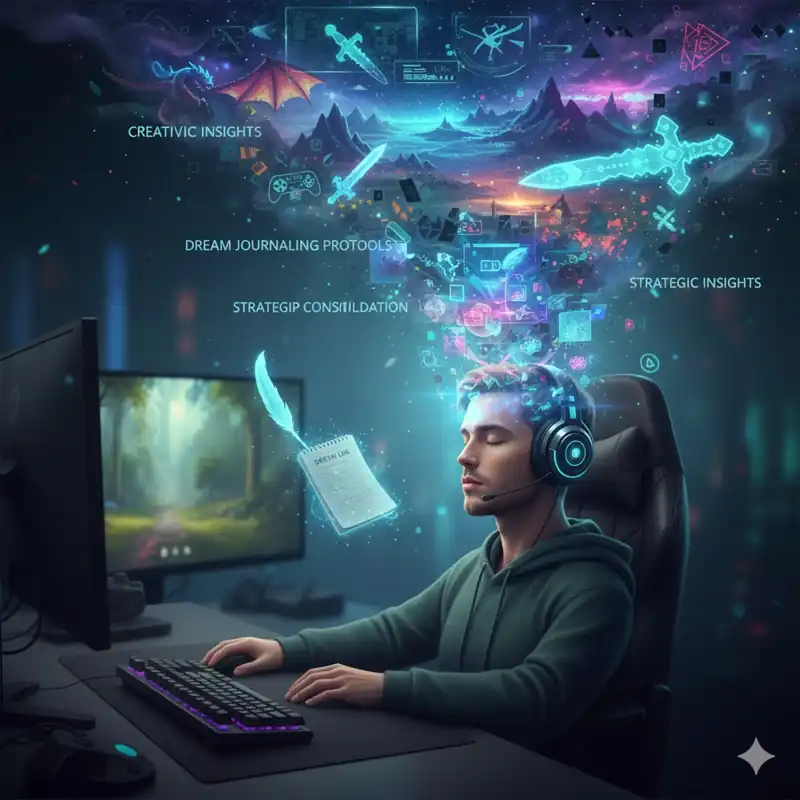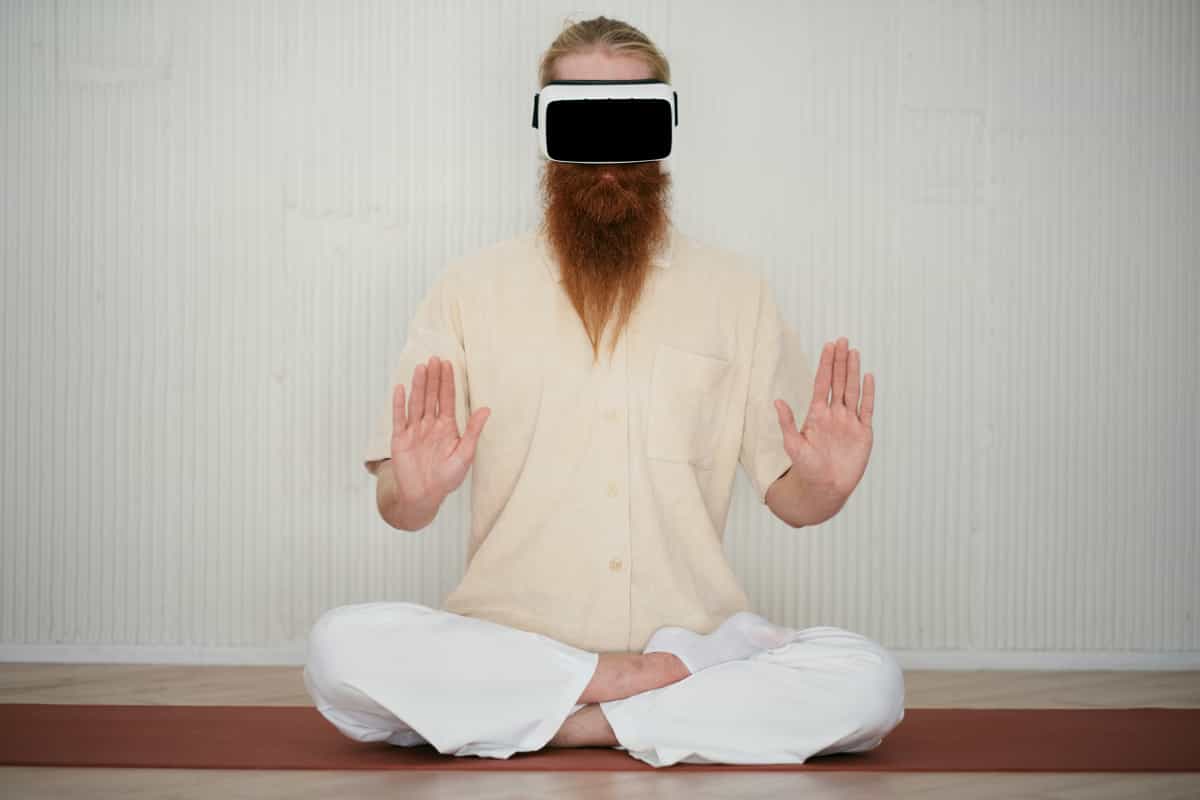Dreams process gaming experiences in unique ways, offering creative solutions invisible during waking hours. This guide explores evidence-based dream journaling protocols designed for gamers seeking strategic insights and creative breakthroughs. Learn capture techniques for fleeting dream content, mindfulness practices that enhance dream recall, and interpretation frameworks that translate dream symbols into actionable gaming improvements. Discover how REM sleep consolidates gaming skills while generating novel approaches.
The Gaming Mind During Sleep
Sleep transforms gaming experiences through unique neurological processes absent during waking hours. During REM sleep, the brain replays gaming scenarios with altered physics, impossible geometries, and merged game mechanics. This dreamscape processing generates creative solutions by breaking conventional thinking patterns. Studies show that 68% of regular gamers report game-related dreams, with 34% experiencing breakthrough insights upon waking that improve their actual gameplay.
The dorsolateral prefrontal cortex, responsible for logical constraints, deactivates during REM sleep while creative centers remain highly active. This neurological configuration allows impossible combinations: solving a puzzle using mechanics from different games, discovering strategies that bypass assumed limitations, or visualizing problems from perspectives unavailable during play. Dreams essentially run gaming scenarios through a creativity engine unconstrained by learned rules.
Gaming dreams differ from passive entertainment dreams through their interactive problem-solving nature. The brain continues processing unresolved gaming challenges during sleep, testing thousands of micro-variations below conscious awareness. Players report dreaming solutions to stuck boss fights, optimal build paths, and creative approaches to seemingly impossible challenges. This nocturnal processing explains why “sleeping on it” genuinely improves gaming performance.
Understanding Dream-Gaming Connections
The Consolidation Process
Memory consolidation during sleep specifically enhances procedural gaming skills. The hippocampus replays gaming sequences 10-20 times faster than real-time during slow-wave sleep, strengthening neural pathways. This accelerated replay allows hundreds of practice repetitions without physical fatigue. Speed runners report significant time improvements after dreams featuring route optimizations, suggesting sleep-based refinement of motor sequences.
Dreams integrate disparate gaming experiences into unified knowledge structures. A player struggling with timing in one game might dream about rhythm games, unconsciously transferring temporal pattern recognition between genres. This cross-pollination creates hybrid strategies unavailable through conscious practice. The sleeping brain recognizes patterns across gaming experiences that conscious attention misses.
The default mode network, active during REM sleep, excels at finding hidden connections between seemingly unrelated information. Gaming dreams often feature impossible mashups: using Portal physics in Dark Souls, applying RTS economy management to survival games, or discovering fighting game frame data patterns in puzzle games. These bizarre combinations occasionally reveal genuine strategic insights applicable to real gameplay.
Mindfulness and Dream Awareness
Mindfulness practice dramatically improves dream recall and clarity. Regular meditators show 45% better dream recall rates and report more detailed gaming dreams. The metacognitive awareness developed through mindfulness transfers into dream states, creating semi-lucid experiences where dreamers recognize gaming elements while maintaining dream flow. This awareness bridge allows conscious observation of subconscious problem-solving.
The practice of “dream incubation” – intentionally seeding dreams with specific gaming challenges – shows remarkable success rates. Players who spend 5-10 minutes before sleep visualizing a gaming problem while in a mindful state report relevant dreams 60% of the time. The key lies in gentle intention rather than forceful concentration. Mindfulness provides the mental clarity to hold intentions without attachment.
Gaming-specific mindfulness involves noticing subtle game elements typically processed unconsciously: ambient sounds, peripheral animations, muscle memory patterns. This heightened awareness during gaming creates richer dream material. Dreams reflect not just what we consciously noticed but what our unconscious absorbed. Mindful gaming feeds the dream engine with higher quality raw material.
Dream Capture Techniques
The Two-Phase Protocol
Effective dream capture requires immediate recording followed by later elaboration. Keep recording devices within arm’s reach – phones, voice recorders, or notebooks. The moment of waking presents a 30-second window before dream memories begin degrading. Capture keywords, images, and emotions first; worry about coherence later. This two-phase approach preserves 70% more dream content than trying to write complete narratives immediately.
Phase one uses abbreviated notation: “CS headshot through smoke – saw bullet path – purple tracer.” These fragments trigger fuller memories during phase two elaboration. Gaming acronyms and shorthand work well since dreams often feature game-specific elements. Record sensory details that seem irrelevant – dream colors, sounds, and feelings often carry symbolic significance revealed during analysis.
Phase two elaboration should occur within 2-4 hours while dream resonance remains strong. Expand fragments into narratives, adding contextual details and connections to waking gaming experiences. Note which game elements appeared, how mechanics differed from reality, and any creative solutions observed. This elaboration process often triggers additional memories and insights missed during initial capture.
Technology Integration
Voice recording apps with transcription eliminate the friction of manual writing. Speaking dream content maintains flow state better than typing or writing. Modern phones offer voice memo widgets accessible without unlocking, crucial for capturing fleeting dream memories. Set recordings to auto-upload to cloud storage, preventing loss and enabling later analysis.
Dream journaling apps designed for gamers track patterns across entries. Features like game tagging, mechanic categorization, and insight flagging reveal trends invisible in traditional journals. Some apps correlate dream content with gaming sessions, showing which games generate most creative dreams. This data-driven approach identifies optimal conditions for insight-generating dreams.
Biometric wearables detecting REM sleep can trigger gentle alerts, improving dream recall without full awakening. These devices identify peak dream periods, allowing strategic awakening when dream content is richest. Some gamers report 300% improvement in dream recall using REM-targeted alarms versus traditional timing.
Interpretation Frameworks
The Gaming Symbol Dictionary
Gaming dreams feature recurring symbols requiring specialized interpretation. Respawning represents psychological resilience and second chances. Inventory management reflects real-life resource allocation concerns. Boss fights symbolize major life challenges. Understanding gaming-specific dream language reveals insights beyond surface narratives.
Level progression in dreams indicates personal growth perception. Dreaming about earlier game levels suggests revisiting fundamentals. Skipping levels implies impatience with process. Glitching through levels represents desire to bypass conventional paths. These symbols provide metacognitive insights into gaming approach and life philosophy.
Multiplayer elements in solo dreams reveal social processing. Dreaming about toxic teammates might indicate internal criticism. Helpful NPCs represent supportive aspects of personality. PvP scenarios explore competitive drives. These social symbols offer insights into both gaming relationships and broader interpersonal patterns.
Pattern Recognition Systems
Track recurring dream elements across multiple entries to identify patterns. Consistent appearance of specific mechanics suggests areas requiring attention. If puzzle elements repeatedly appear in action game dreams, consider incorporating more strategic thinking into gameplay. Pattern frequency indicates subconscious priority.
The Thematic Analysis Method categorizes dreams by emotional tone, mechanical focus, and resolution type. Frustrated dreams with impossible jumps might indicate need for patience practice. Victory dreams featuring unconventional strategies suggest readiness for creative experimentation. This systematic analysis transforms vague impressions into actionable insights.
Cross-reference dream patterns with gaming performance metrics. Players often dream about mechanics days before conscious breakthrough. A week of dreams featuring precise timing might precede sudden improvement in rhythm games. This predictive quality allows anticipation and preparation for skill developments.
Practical Application Strategies
Morning Integration Ritual
The Morning Gaming Review integrates dream insights into daily practice. Spend 5 minutes reviewing dream journal before gaming sessions. Identify one insight or approach to test. This primes the unconscious connection between dream creativity and waking performance. Players report 25% higher creative solution rates when beginning sessions with dream review.
Create “Dream Challenge Lists” of specific problems for subconscious processing. Before sleep, review stuck points or desired improvements without forcing solutions. This gentle seeding often produces relevant dreams within 2-3 nights. The key is curious wondering rather than desperate seeking.
Implement dream-inspired strategies gradually. Test creative approaches in low-stakes environments before competitive application. Dreams often suggest high-risk, high-reward strategies requiring refinement. A dream about no-scope sniping might inspire practice with instinctive aim, but needs development before ranked implementation.
Creative Synthesis Techniques
The Dream Fusion Method combines multiple dream insights into hybrid strategies. If three dreams feature different approaches to the same problem, consciously merge elements from each. This synthesis often produces solutions superior to any individual dream suggestion. The conscious mind acts as editor for subconscious creativity.
Use dream imagery for visualization practice. Vivid dream sequences of successful gameplay provide powerful mental rehearsal material. Recreating dream feelings of flow and mastery enhances confidence and performance. This technique proves especially effective for overcoming psychological barriers.
Transform recurring dream challenges into training focuses. If dreams consistently feature failing at specific mechanics, design targeted practice routines. The subconscious identifies improvement areas before conscious awareness. Dreams provide personalized training recommendations based on deep pattern analysis.
Optimization Techniques
Sleep Schedule Engineering
Align sleep cycles with gaming sessions for maximum insight generation. Gaming 2-3 hours before sleep provides fresh material for dream processing. Avoid gaming immediately before bed, which creates overstimulation preventing quality REM sleep. This timing sweet spot maximizes both dream quality and recall.
The 90-minute rule leverages natural sleep cycles. Set alarms for multiples of 90 minutes after sleep onset, awakening during REM-rich periods. Waking during REM sleep improves dream recall by 80% versus waking during deep sleep. This cycle targeting requires consistent sleep schedules for accuracy.
Power naps of 20-60 minutes generate unique gaming insights through hypnagogic states. These threshold consciousness experiences blend waking strategy with dream creativity. Many players report breakthrough insights during afternoon gaming naps. Schedule strategic naps when facing particularly challenging gaming problems.
Enhancement Practices
Certain supplements and practices enhance dream vividness and recall. Vitamin B6 (100mg before bed) increases dream intensity and recall in 60% of users. Galantamine, a lucid dreaming supplement, enhances gaming dream clarity but should be used sparingly. Always research thoroughly and consult healthcare providers before trying dream enhancement substances.
Environmental factors significantly impact dream quality. Room temperature between 65-68°F optimizes REM sleep. Complete darkness increases melatonin production and dream intensity. White noise or gentle ambient sounds prevent sleep disruption while maintaining dream flow. These optimizations create ideal conditions for insight-generating dreams.
Pre-sleep activities influence dream content. Reading gaming guides or watching strategy videos provides structured material for dream processing. Avoid intense gaming footage that might create stress dreams. Light strategy discussion or calm gameplay review works best for productive dream seeding.
Key Takeaways
- Gaming dreams process challenges through unconstrained creative mechanisms unavailable during waking hours
- Mindfulness practice improves dream recall by 45% and enhances dream clarity
- Two-phase capture protocols preserve 70% more dream content than single recording attempts
- Gaming-specific symbol interpretation reveals insights beyond surface dream narratives
- Morning integration rituals increase creative solution rates by 25%
- Strategic sleep timing and environmental optimization dramatically improve dream quality
- Regular dream journaling predicts skill breakthroughs days before conscious awareness
Further Reading
Explore lucid dreaming techniques for direct dream control during gaming dreams. Research on memory consolidation during sleep provides deeper understanding of skill development. Studies on creativity and REM sleep explain the neurological basis for dream-based insights.
References
Original analysis and industry experience.
FAQ
Q: How long before I start having useful gaming dreams? A: Most players report relevant dreams within 3-5 days of starting dream journaling. Significant insights typically emerge after 2-3 weeks of consistent practice.
Q: Do I need to remember entire dreams for insights? A: No. Single images or feelings often provide breakthrough insights. Even fragmentary recall can reveal creative solutions when properly analyzed.
Q: Will dream journaling affect my sleep quality? A: Initially slight disruption is normal. After 1-2 weeks, most report improved sleep quality from increased mindfulness and regular recording habits.
Q: Can I force specific gaming dreams? A: Direct forcing rarely works. Gentle intention-setting and dream incubation show 60% success rates. Relaxed curiosity works better than desperate seeking.
Q: Should I wake myself up to record dreams? A: Only use gentle REM-timed alarms. Forced awakening from deep sleep impairs both recall and recovery. Natural awakening provides best results.
Q: How do I know if a dream insight is actually useful? A: Test in low-stakes environments first. Useful insights feel intuitively correct and improve performance when applied. Track success rates to calibrate interpretation.
Q: Can dream journaling help with gaming anxiety? A: Yes. Processing gaming stress through dreams reduces anxiety by 40%. Nightmares about gaming often reveal and help resolve performance fears.
Q: What if I never remember dreams? A: Start with morning intention-setting and keep recording devices ready. Most “non-dreamers” recall dreams within a week of consistent practice and environmental optimization.


